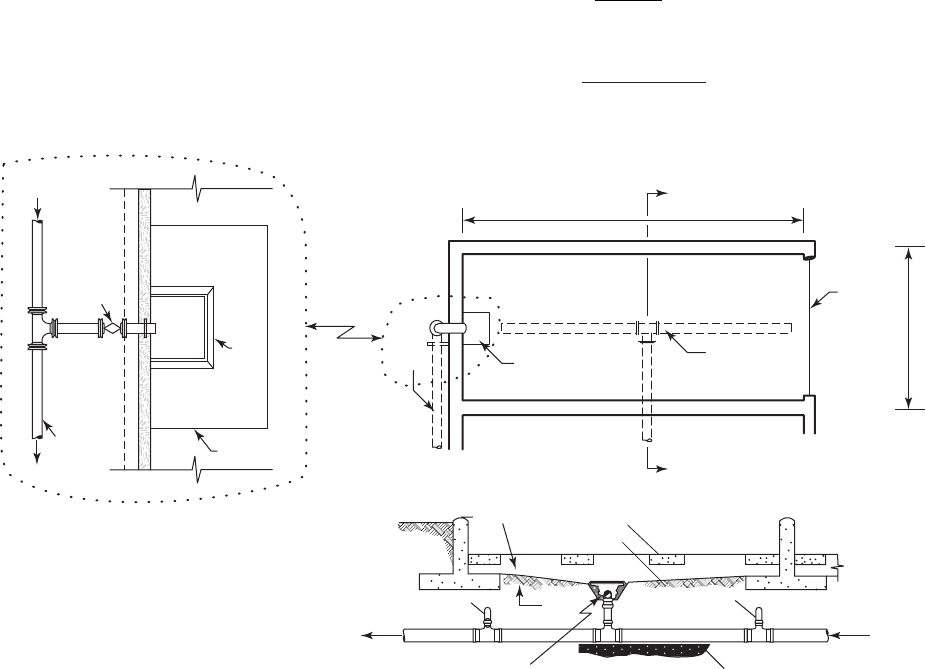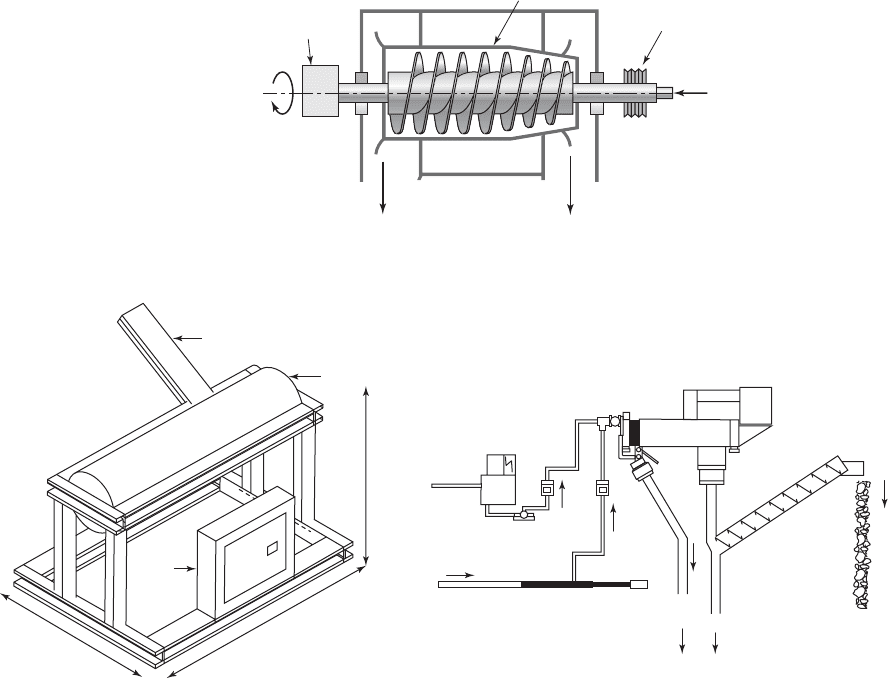Water and Wastewater Engineering
Подождите немного. Документ загружается.


WATER PLANT RESIDUALS MANAGEMENT 15-27
Example 15-5. Design a sludge lagoon to dewater a coagulation sludge. The sludge flow rate
is 85.6 m
3
/ d, and the solids concentration from a thickener is 2.5%. Assume a wet climate, a
four lagoon system with a six-month cycle for each lagoon, and an applied depth of 0.40 m.
Solution:
a . Using a six-month cycle, the number of lagoon uses per year will be
N
12
6
2
mo/y
mo/cycle
cycles/year
b. The total area of the four lagoons is estimated as
A
s
()()
()()
85 6 365
2080
3
.
.
m /dd/y
cycles/y m
(()4
4 881 88 5 000
2
lagoons
or m ,. ,
Comments:
1 . This is a fairly conservative design because of the assumption of a wet climate.
2. If the lagoon is also to be used for thickening, the area may have to be increased substantially.
Solids dewatered
Coagulant 7 to 10%
Lime 30 to 50%
Capacity 3 to 4 months If depth is provided
for storage, may be as
long as 3 years
Depth of liquid sludge 1.2 to 1.8 m During filling, 1.2 m
preferred
Length to width 4:1
Inlet to outlet distance 30 m Minimum
Lining Clay and/or HDPE Local regulations
may require leachate
collection
Berms
Slope 3:1 Horizontal to vertical
Access road 5 m wideWide enough for
excavation equipment
and double bottom
trailers to maneuver
Sources: Kawamura, 2000; Peck and Russell, 2005.
15-28 WATER AND WASTEWATER ENGINEERING
Sand Drying Beds. Sludge is dewatered on a sand drying bed by three mechanisms: drainage,
decanting, and evaporation. First, the water is drained from the sludge, into the sand, and out the
underdrains. This process may last a few days until the sand is clogged with fine particles or until
all the free water has drained away. Decanting can occur once a supernatant layer has formed.
Decanting for removal of rain water can also be particularly important with sludges that do not
crack.
The water that does not drain or is not decanted must evaporate. Climate plays a significant
role in the feasibility of using this dry
ing technique. Phoenix would be a more efficient area for
a sand bed than Seattle!
Drying bed options may be roughly described as follows:
• Conventional rectangular beds have side walls and a layer of sand on gravel with under-
drain piping to carry away the liquid. They have been built either with or without provisions
for mechanic
al removal of the dried sludge, and with or without a roof or a greenhouse-type
covering. In the United States, the capital cost of roofing over a s and drying bed of any
appreciable size probably precludes it from being built. The cost of labor is such that me-
chanical sludge removal will, in all likelihood, be more economical than manual removal.
• Paved rectangular drying beds are built with a center sand drainage strip with or without
heating pipes buried in the paved section, and with or without covering to prevent incursion
of rain.
• “Wedge-water” drying beds include a wedge wire septum incorporating provision for an
initial flood with a thin layer of water. This is followed by introduction of liquid slu
dge on
top of the water layer, controlled formation of cake, and provision for mechanical cleaning.
• Rectangular vacuum-assisted drying beds are built with provision for application of vacuum
to assist gravity drainage.
Operational procedures common to all types of drying beds involve the following steps
(ASCE, 1990):
1 . Pump sludge onto the
drying bed surface.
2. Add chemical conditioners continuously by injection into the sludge as it is pumped
onto the bed. Anionic, cationic, and nonionic polymer have all been used successfully
in individual application. However, a combination of polymers
may give the best dewa-
tering characteristics (Ayol, Dentel, and Filibeli, 2005). Polymer doses fall in the range
of 1 to 10 g/kg of sludge solids (MWH, 2005).
3. When the bed is filled to the desired level, allow the sludge to drain and dry to the desired
final solids concentration. This concentration can vary fro
m 15 to 30 percent for coagu-
lant sludge and 50 to 70 percent for lime sludge.
4. Remove the dewatered sludge either mechanically or manually.
5. Repeat the cycle.
Periodically, sand that is inadvertently picked up when the dewatered sludge is remove
d
must be replaced.

WATER PLANT RESIDUALS MANAGEMENT 15-29
The filtrate from the sand drying beds can be either recycled, treated, or discharged to a
watercourse depending on its quality.
I deally, pilot testing is conducted prior to design of the sand drying bed. The pilot tests
provide data on the loading d epth, initial solids concentration, and polymer
use that maximizes
the drained solids concentration. Some example data are shown in Table 15-7 . Although similar
data for lime sludges are not available, typical loading depths of 0.3 to 1.2 m have been reported
(ASCE, 1990). From the data trends it is apparent that there is a general trend of diminishing
return in drained soli
ds concentration with increased loading.
Laboratory testing of the filtrate from the pilot tests provides data for the decision on the
final disposition of the filtrate and decant.
Sand Drying Bed Design. Current United States practice is to make drying bed cells rectan-
gular with dimensions of 4 to 20 m by 15 to 60 m, with vertical si
de walls 1 to 1.5 m above the
sand surface. For mechanical sludge removal, the dimensions should be selected to accommodate
the removal equipment, that is, multiples of the loader bucket width. In a typical design, 0.3
to 0.46 m of sand is placed over 0.
3 to 0.46 m of graded gravel or stone. The sand is specified
with an effective diameter that ranges from 0.3 to 1.2 mm and a uniformity coefficient from 3.5
TABLE 15-7
Example pilot test results
Sludge type
Initial solids
concentration, % Loading, kg/m
2
Initial depth, m
Drained solids
concentration, %
Polymer dose,
g/kg
Alum 1.1 5 0.44 8.5 1.0 N
10 0.88 7.3
15 1.31 6.9
20 1.755.8
Alum 6.5 10 1.48 16.2 1.55 A
20 2.95 19.1
30 4.42 11.8
Polyaluminum chloride 1.7 10 0.57 12.2 1.2 C
20 .45 10.0
30 1.13 12.1
Ferric chloride 1.9 5 0.25 6.3 4.2 C
10 0.506.3
20 1.0 3.2
Ferric
chloride6.5 10 1.48 23.2 1.25 A
15 2.20 21.7
20 4.42 20.3
N nonionic polymer
A anionic polymer
C cationic polymer
A dapted from Cornwell and Vandermeyden, 1999.

15-30 WATER AND WASTEWATER ENGINEERING
to 5.0. Gravel is normally graded from 3 to 25 mm in effective diameter. Underdrain piping has
normally been of vitrified clay, but plastic piping is also acceptable. The pipes should be no less
than 100 mm in diameter, should be spaced 2 to 6 m apart, and should have a minimum slope of
1 percent.
Mechanical equipment such as a front end loader is used to remove the dried sludge. Bed
runners consisting of 10 by 30 cm concrete pads provide a drive way for the wheels of the front
end loader, so the loader does not compact the sand. In addition, they
serve as a guide for buckets
to rest on as sludge is picked up. This minimizes the amount of sand that is picked up by the
loader when it removes the sludge. A typical layout is shown in Figure 15-7.
Cornwell and Vand ermeyden (1999) proposed
a model for developing the sand bed design
based on a monthly mass balance of water. The working equations for the model are as follows:
DD
P
P
d i
s
s
()
initial
drained
⎛
⎝
⎜
⎞
⎠
⎟
(15-28)
D
DD
DP
P
ed
ds
s
()( )
drained
final
⎛
⎝
⎜
⎞
⎠
⎟
(15-29)
Thickened
sludge
Plug
valve
Inlet
box
Splash pad
To next
bed
Splash
pad
Drain
tile
Bed runners
Liner (as required)
Stop
gate
4–20 m
15–60 m
A
A
Sludge
line
Exploded view
Section A-A
(c)
(a)
(b)
Sand
PVC pipe from
decant system
PVC pipe from
decant system
Drain tile tee
connection
Gravel
entire run
To treatment
or
disposal
Drainage
from
next bed
Stone
(typ.)
FIGURE 15-7
Sand drying bed. ( a ) Plan view, ( b ) cross section, ( c ) exploded view of inlet.

WATER PLANT RESIDUALS MANAGEMENT 15-31
L
D P
is
()( )()
initial
(15-30)
A
M
L
s
st
()
(15-31)
where D
d
drained residuals depth after free water is removed, m
D
i
initial residuals depth, m
P
s initial
initial solids fraction
P
s drained
solids fraction after drain and decant
D
e
required depth change to be caused by evaporation, m
P
s final
desired final solids fraction
L loading, kg/m
2
density of water
1,000 kg/m
3
A
s
surface area of sand bed, m
2
M
s ( t )
mass of dry solids produced per unit of time, kg/month
The following steps outline the design procedure:
1 . On a monthly basis, estimate the solids production.
2. Compu te the monthly net evaporation rate, that is, the pan evaporation rate minus the
precipitation, for the location of the sand drying bed. Sour
ces for the pan evaporation
rate and precipitation data include the National Weather Service and State Climatology
Offices. While precipitation data are widely available, pan evaporation data are sparse.
For academic purposes, U.S. Army Corps of Engineers monthly maps of pan evaporation
isopleths (Appendix H, EM 1110-2-5027, 1987) have been reproduced in the Chapter 15
folder at www.mhprofessional.c
om/wwe .
3. Select a loading rate ( L ) and calculate a drained/decanted depth ( D
d
) using Equation
15-28 and data from pilot testing or sim ilar treatment facilities. In the absence of pilot
testing, the data in Table 15-7 may provide a basis to make an estimate.
4. Calculate the required evaporative drying ( D
e
) in terms of meters of evaporation using
Equation 15-29.
5. Using Equation 15-31 , calculate the area required ( A
s
) for the selected loading rate ( L ).
6. Using the net evaporation data, determine the number of months, rounded to the next
highest integer number, to achieve D
e
.
7. On a monthly basis, repeat steps 1 through 7 for an annual cycle.
8. Construct a mass balance accounting table of the area required for drying ( A
s
) for each
month taking into account the number of months required to dry a bed.
The most convenient way to calculate the mass balance is to begin with a month following
that which has no “carryover” of solids. Carryover is when more than one month is required for
the net evaporation to equal or exceed the required evaporation. In subsequent months, when

15-32 WATER AND WASTEWATER ENGINEERING
more than one month’s evaporation is required, there will be a “carryover” bed area. This area
is carried forward. In other months, more evaporation is available than is required. This area is
“used” to reduce the carryover. The maximum area carried forward is the required bed area.
The calculation process is illustrated in the following exam
ple problem.
Example 15-6. For the alum solids production and net evaporation rate shown below, deter-
mine the total bed area required.
Month Solids production, kg/d Net evaporation, cm/mo
Jan 3,519 2.5
Feb 3,724 4.8
Mar 4,115 8.9
Apr 4,208 11.9
May 2,369 14.7
Jun1,528 17.5
Jul 1,458 17.8
Aug 2,196 16.5
Sep 1,415 11.4
Oct 1,856 8.9
Nov 1,642 6.6
Dec 2,012 4.6
Based on pilot data in Table 15-7 , the following design assumptions were made:
Initial sludge depth 0.875 m
Initial solids concentration 1.1%
Drained solids concentration 7.3%
D e sired final solids concentration 20%
( Note: from the pilot data, an initial sludge depth of 0.875 m implies a loading of 10 kg/m
2
.)
Solution: The spreadsheet solution is shown below. The explanation of the column calcula-
tions is given below the table.
a . The original solids production and net evaporation data are reprod uced in columns
2 and 4. To begin, with the exception of the last two colu mns, the mass balance was
computed starting in January. Then, by observation, a convenient starting point was
se-
lected so that the evaporation exceeded D
e
and thus resulted in no carryover of solids
into the following month. October met this requirement and also was convenient in that
it preceded the wet s eason when increased bed area is anticipated. The table was then
rearranged so that it started with October.
b. The data in column 3 is the product of column 2 and
the number of days in the month.
For example, for the first row:
()()1 871 31 58 001,,kg/dd/mo kg/mo

WATER PLANT RESIDUALS MANAGEMENT 15-33
c. The data in column 5 is a conversion to consistent units, that is, m/mo.
d. Column 6 is the computation of the drained depth. For example, for the first row, where
D
i
0.875 m, P
s initial
0.011, and P
s drained
0.073:
D
d
()0875
0 011
0073
01318 0 132.
.
.
..
⎛
⎝
⎞
⎠
or
e. Column 7 is the computation of D
e
, the required depth change to be caused by evapora-
tion. For the first row, where D
d
0.132, P
s drained
0.073, and P
s final
0.20:
D
e
0132
01318 0 073
020
00839.
..
.
.
()()
⎛
⎝
⎞
⎠
or m0 084.
f. Column 8 is the sludge loading based on the note given in the problem statement.
g. Column 9 is the area required for the sludge. For the first row, with the October sludge
production of 58,0001 kg, this is:
A
s
()()58 001 1
10
800
2
2
,
5,
kg mo
kg/mo m
m
h. The time to dry is computed in column 10. This is best illustrated for the second row (NOV):
Total required evaporation 0.084 m from c olumn 7. The net evaporation for each
month is given in column 5.
(1) (2) (3) (4) (5) (6) (7) (8) (9) (10) (11)
Month
Solids
production,
kg/d
Solids
production,
kg/mo
Net
evaporation,
cm/mo
Net
evaporation,
m/mo
D(d),
m
Delta
D(e),
m
L, kg/
m
2
A
s
, m
2
Time to
dry, mo
Total
bed area
required,
m
2
OCT 1871 58001 8.9 0.089 0.132 0.084 10.00 5,800 1 5800
NOV 1656 49680 6.6 0.066 0.132 0.084 10.00 4,968 2 4968
DEC 2028 62868 4.6 0.046 0.132 0.084 10.00 6,287 3 11255
JAN 3547 1099572.5 0.025 0.132 0.084 10.00 10,996 3 17283
FEB 3753 105084 4.8 0.048 0.132 0.084 10.00 10,508 2 27791
MAR 4148 128588 8.9 0.089 0.132 0.084 10.00 12,8591 34333
APR 4241 127230 11.9 0.119 0.132 0.084 10.00 12,723 1 12723
MAY 2388 74028 14.7 0.147 0.132 0.084 10.00 7,403 1 7403
JUN 1540 46200 17.5 0.175 0.132 0.084 10.00 4,620 1 4620
JUL 1470 45570 17.8 0.178 0.132 0.084 10.00 4,5571 4557
AUG 2214 68634 16.5 0.165 0.132 0.084 10.00 6,863 1 686
3
SEP 1427 42810 11.4 0.114 0.132 0.084 10.00 4,281 1 4281
Sum 918650 kg 1.261 m

15-34 WATER AND WASTEWATER ENGINEERING
November net evaporation 0.066 m. This is less than 0.084 m so another month of
drying is required.
December net evaporation 0.046 m. The total for NOV and DEC 0.112 m. This is
greater than 0.084 m so the total time to dry is then two months, that is, NOV and DEC.
Although only a fraction of December would be required to complete drying, a con-
servative estimate of a whole month is used to allow for abnormal weather and time to
remove the sludge.
i. The total bed area is a running accumulation of the required bed area with an assump-
tion that the sludge drying begins the month that it is placed. Another spreadsheet was
developed for these computations. It is shown below.
(1) (2) (3) (4) (5) (6) (7)
Month Bed area
required for
month
Carry/over m
2
NOV
Carry/over m
2
DEC
Carry/over m
2
JAN
Carry/over m
2
FEB
Total bed area
required m
2
OCT 5,800 5,800
NOV 4,968 4,968
DEC 6,287 4968 11,255
JAN 10,996 6287 17,283
FEB 10,508 6287 10,996 27,791
MAR 12,859 10,966 10508 34,333
APR 12,723 12,723
MAY 7,403 7,403
JUN 4,620 4,620
JUL 4,5574,557
AUG 6,863 6,863
SEP 4,281 4,281
The second column is the bed area calculated as A
s
in column 9 of the first spread-
sheet. The “carryover” columns (3 through 6) indicate the area occupied in subsequent
months from the month the sludge was placed. The number of months that carryover on
the sludge drying beds was calculated as in step h and is
listed in column 9 of the first
spreadsheet. For example, sludge placed in NOV requires two months to dry. Therefore,
it appears in the month it was placed and in the row for DEC. The total area occupied in
the month of DEC is the sum of that placed in DEC and the carryover from NOV.
j. The maximum total bed area required occurs
in MAR. It is 34,333 m
2
or 35,000 m
2
.
Comments:
1 . The total area of the sand drying beds should be divided into cells that allow the opera-
tion and maintenance personnel flexibility in loading and unloading.
2. An estimate of the area based on the annual net evaporation may yield very misleading
results. This is particularly true if high sludge prod
uction occurs when the net evaporation

WATER PLANT RESIDUALS MANAGEMENT 15-35
is low as shown in this example. A typical occurrence is when rains bring high turbidity.
Thus, the sludge production goes up while the rains reduce the net evaporation.
3. In climates where there is a season with little or no evaporation, either storage is pro-
vided or sufficient beds are provided to store the sludge until evaporative drying c
an take
place. These climates may be cold enough to take advantage of additional dewatering by
freezing and thawing of the sludge.
Freeze Treatment. Dewatering sludge by either of the nonmechanical methods may be en-
hanced by physical conditioning of the sludge through alternate natural freezing and thawing
cycles. The freeze-thaw process dehyd
rates the sludge particles by freezing the water that is
closely associated with the particles. The dewatering process takes place in two stages. The first
stage reduces sludge volume by selectively freezing the water molecules. Next, the solids are
dehydrated when they become frozen. When thawed, the solid
mass forms granular-shaped par-
ticles. This coarse material readily settles and retains its new size and shape. This residue sludge
dewaters rapidly and makes suitable landfill material.
The supernatant liquid from this process can be decante
d, leaving the solids to dewater by
natural drainage and evaporation. Pilot-scale systems can be utilized to evaluate this method’s
effectiveness and to establish design parameters. Elimination of rain and snow from the dewater-
ing system by the provision of a roof will enhance the process considerably.
The potential advantages of a freeze-thaw
system are
1 . Insensitivity to variations in sludge quality.
2. No conditioning required.
3. Minimum operator attention.
4. Natural process in cold climates (winter).
5. Solids cake more acceptable at landfills.
6. Sludge easily worked with conventional equipment.
Several natural freeze-thaw installation
s are located in New York state. At the alum coagula-
tion plant of the Metropolitan Water Board of Oswego County, SFBW is discharged to lagoons
that act as dec ant basins. Thickened sludge is pumped from the lagoons to special freeze-thaw
basins in layers about 450 mm thick. The slud ge has never been deeper than 3
00 mm during
freezing because of additional water losses. The 300 mm sludge layer reduces to about 75 mm of
dried material after freeze-thaw (Davis and Cornwell, 2008).
Solar Drying Beds. These beds are similar in construction and operation to conventional sand
drying beds. They differ in that they are constructed with sealed bottoms. Th
us, there is no provi-
sion for water to be removed through drainage. Because they rely primarily on evaporation, they
typically have lower solids loading rates and filling depths of liquid sludge are less. These beds
are cheaper to build and operate than conventional sand drying beds because there is no cost for
und
erdrains and cleaning with front-end loaders is quicker without incurring sand loss. Most
solar beds are located in the southern and southwestern parts of the United States where evapora-
tion rates are high (Cornwell, 1999).

15-36 WATER AND WASTEWATER ENGINEERING
Mechanical Dewatering
Centrifuging. A centrifuge uses centrifugal force to speed up the separation of sludge particles
from the liquid. In a typical unit ( Figure 15-8 ), sludge is pumped into a horizontal, cylindrical
bowl, rotating at 800 to 2,000 rpm. This results in an applied force of 1,500 to 4,000 times the
force of the acceleration due to gravity. Pol
ymers used for sludge conditioning also are injected
directly into the centrifuge. The solids are spun to the outside of the bowl where they are scraped
out by a screw conveyor. The liquid, or centrate, is returned to the treatment plant. Two types
of centrifuges are currently used
for sludge dewatering: the solid bowl and the basket bowl. For
dewatering water treatment plant sludges, the solid-bowl scroll centrifuge has proven to be more
successful than the basket bowl.
Length
Height
Wi
d
th
Discharge conveyor
Centrifuge
Control
box
(b)
(a)
Polymer
system
Sludge
Drive system
Centrifuge
Dewatered
solids
conveyor
Solids
Studge feed pump
Centrate
discharge
Conveyor
drain
Liquid
Cake solids
dischrage
Drive sheave
Feed
Solid
discharge
Liquid
discharge
Gear box
Rotating bowl
(c)
FIGURE 15-8
Solid bowl centrifuge. ( a ) Schematic, ( b ) isometric, ( c ) process layout. (Schematic Courtesy Bird Machine Company.)
